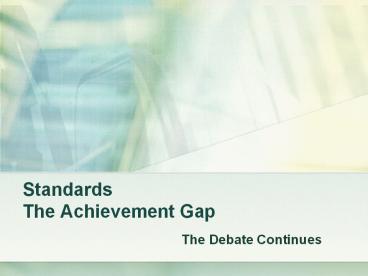Standards The Achievement Gap - PowerPoint PPT Presentation
1 / 21
Title:
Standards The Achievement Gap
Description:
Standards The Achievement Gap The Debate Continues SOME BIG QUESTIONS How do standards relate to thinking-rich classrooms and helping all students learn ... – PowerPoint PPT presentation
Number of Views:136
Avg rating:3.0/5.0
Title: Standards The Achievement Gap
1
StandardsThe Achievement Gap
- The Debate Continues
2
SOME BIG QUESTIONS
- How do standards relate to thinking-rich
classrooms and helping all students learn
course content? - What is your responsibility as educator in
meeting particular standards and meeting the
needs of students? - What is your responsibility as educator in
ameliorating the achievement gap?
3
(No Transcript)
4
First
- Move to one part of the room based on thoughts on
this statement - Standards are necessary for increased learning.
- Front agree
- Back disagree
- Why are you positioned where you are?
5
Achievement Gap
- Position 1 Integration, Title I, and Head Start
have been effective and should continue. - Position 2 New programs like NCLB needed because
old programs are not effective.
6
Danielle Case
- How do standards affect Danielle?
- How does standardized testing affect Danielle?
- How does the achievement gap affect Danielle?
- What does she need to be thinking about in
relation to how she can develop a thinking-rich
classroom while keeping in mind issues related to
standards, testing, and the achievement gap?
7
Why have standards?
- Previously benchmark was level of completion
- Indicators that US falling behind
8
A Nation at Risk
- 1983. Alarmist call for better schools
- Our Nation is at risk. Our once unchallenged
preeminence in commerce, industry, science, and
technological innovation is being overtaken by
competitors throughout the world. ( 1) - If an unfriendly foreign power had attempted to
impose on America the mediocre educational
performance that exists today, we might well have
viewed it as an act of war. We have, in effect,
been committing an act of unthinking, unilateral
educational disarmament. ( 2).
9
NAEP
- The Nations Report Card
- Started 1969
- Only nationally representative and continuing
assessment for K-12 students - Based on a sample of student population
- No individual scores aggregate and by population
(e.g. females/males, African-American/
Asian-American/ Caucasian/ Hispanic)
10
NAEP
- Includes public and private schools
- Grades 4, 8, 12
- Test stays same stability
- Reading, Math, Science, Writing, US History,
Civics, Arts - Levels
- basic, proficient, advanced
11
NAEP Reading Results 2002
- Based on 270,000 students at 11,000 schools
- 12th graders at or above basic or proficient
decreased between 1998 and 2002 - 8th graders at or above basic was higher than in
all previous years - Females scored higher than males
- White and Asian students higher than black and
Hispanic
12
NAEP Reading Results 2002
- Students attending schools receiving Title I
funds scored lower (average) than students
attending schools not receiving Title I funds. - Students who attended nonpublic schools had
higher average scores than students in public
schools. - Students in urban fringe/ large town areas had
higher average scores than students in central
city or rural areas.
13
No Child Left Behind
- Re-tooled ESEA 1965
- Focuses on
- Increased funding for poor districts
- Higher achievement for poor and minority students
- New accountability measures for students
progress - Dramatically expanding the role of standardized
testing in schools
14
NCLB
- Reform principles
- Accountability
- Flexibility
- Research-based reforms
- Parental options
- States test every child in grades 3-8
- Some states also have minimum competencies for
graduation - Funding issues reading, reform, vouchers
15
NCLB
- Does not represent national curriculum
- Progress met through states setting targets for
AYP in math and reading - AYP Goal is to have every student proficient in
math and reading by 2014 - If AYP not met
- 1-2 years School improvement
- 3 years Correction action
- 4 years Possible restructuring
16
NCLB and Parents
- Receive report card with scores
- Scores disaggregated by subgroups based on race,
ethnicity, gender, low-income status, disability
status, migrant status, ELL (English Language
Learners) - Professional qualifications of teachers (highly
qualified) - Right to transfer if school failing 3 years
17
The illustrious achievement gap
- Equal access ? equal opportunities.
- WHY??
18
Barton1 Before and beyond school
- Birthweight
- Lead poisoning
- Hunger and nutrition
- Television watching
- Parent availability
- Student mobility
- Parent participation
- Reading to young children
1Barton, P. E. (2004). Why does the gap persist?
Educational Leadership, 62(3), 8-13.
19
Barton1 In school
- Teacher experience and attendance
- Teacher preparation
- Class size
- Technology-assisted instruction
- School safety
- Rigor of curriculum
1Barton, P. E. (2004). Why does the gap persist?
Educational Leadership, 62(3), 8-13.
20
Questions to Continue to Ponder
- What is your responsibility as educator in
ameliorating the achievement gap? - What is your responsibility as educator in
meeting particular standards and meeting the
needs of students?
21
Next Class
- Diagnostic tools How can we determine what
students need and what readings are appropriate?
- Vacca and Vacca pp. 40-68
- Bring to class a sample reading you may use with
your students































